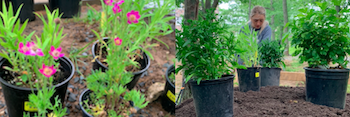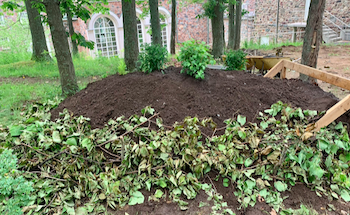Today@Dal
» Go to news mainStudent‑led pollinator garden adds to campus green infrastructure

With the addition of a new pollinator garden to the Studley campus environment, butterflies, bees and birds will soon have a new spot to carry out their life cycles: a 'hugelkultur bed' that will serve as a sustainability feature and an attraction for the Dalhousie community.
 The event was funded by WWF Canada Go Wild Grant and built behind the Shirreff Hall Woodland on Studley Campus. Samantha Ceci and her team in collaboration with the Office of Sustainability and Facilities Management worked on restoring a monoculture woodland area on campus into a mixed forest to support a diversity of pollinator species.
The event was funded by WWF Canada Go Wild Grant and built behind the Shirreff Hall Woodland on Studley Campus. Samantha Ceci and her team in collaboration with the Office of Sustainability and Facilities Management worked on restoring a monoculture woodland area on campus into a mixed forest to support a diversity of pollinator species.
"I was really fascinated with idea that people were growing food in a community garden using the by-product and scraps found around the space. I thought this a very sustainable solution" -Samantha Ceci
What is a hugelkultur bed?
A hugelkultur bed is a mount-shaped raised garden bed that is created using different shapes and sizes of wood debris. Over time as the debris underneath churns and starts to digest creates more fertile soil for the plants to grow their roots in. The mound shape of the hugelkultur bed introduces micro-topography into space allowing plant species to grow on that mount and each location within it has different light conditions, water availability that enhances biodiversity.
Event highlights/ Process
- The event started with land acknowledgement and distributing tasks amongst the volunteers
- The first step was placing coarse woody material like tree stumps, within the frame of the bed (4'x8') and fill the spaces between the stumps with wood chips.
- Then branches were layered on top of the stumps. The branches decreased in thickness as the bed was building up.
- Over and between the branches leaves were added.
- Brush matressing was performed over the top of the leaves by weaving coniferous and deciduous branches amongst each other. Doing so leaves to help retain and stabilize this loose material.
- Finally, the bed was covered in 6" of soil and native pollinator species were planted within this immediate soil horizon.
Plant Species
 The plant species that were chosen each possess a unique colour and shape of the flower, so as to provide pollinator species with a variety of energy sources. The plants also flower at different times of the year, staggered from June to October. The overall goal behind selecting the plant species for this event was to address the phenological mismatch between plants and pollinators, which is being exacerbated by climate change.
The plant species that were chosen each possess a unique colour and shape of the flower, so as to provide pollinator species with a variety of energy sources. The plants also flower at different times of the year, staggered from June to October. The overall goal behind selecting the plant species for this event was to address the phenological mismatch between plants and pollinators, which is being exacerbated by climate change.
Plant Type |
Plant Name |
Fruiting Shrub |
Common witch hazel (Hamamelis virginiana) |
Broadleaf Evergreen |
Dakota Goldrush® Potentilla (Potentilla fruticosa |
Broadleaf Evergreen |
American highbush cranberry (Viburnum opulus var americanum) |
Flowering perennial |
New England Aster (Aster novae-angliae) 'Alma Potschke' |
Flowering perennial |
Annabella Deep Pink Cut-Leaved Windflower (Anenome multifida) |
Flowering perennial |
Alert New York Aster (Symphyotrichum novi-belgii |
Students, staff and faculty members on campus are encouraged to visit the pollinator garden, where they will be able to learn about the building process and observe plant growth through different seasons. We hope that people visiting the garden will be inspired to adopt pollinator-friendly habits in their own lives.
To learn more visit @soiledthebedproject on Instagram.

